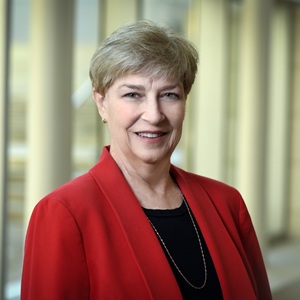
Claire M. Bassett (she/her)
Chief Communications Officer
Baylor College of Medicine
We caught up with Claire Bassett to discover more about her, what she’s up to, and what we can learn from her.
Briefly describe your current role.
I am responsible for overseeing the comprehensive communications strategy that aligns with Baylor College of Medicine’s strategic priorities. This includes overseeing the areas of media relations, internal and external communications, graphic design, marketing, and community engagement as well as managing communications during any crisis or disaster.
Briefly describe your career journey and what led you to institutional advancement in academic medicine.
My 43-year career has been at Baylor College of Medicine, where I started in an entry-level position in communications. I have worked for four presidents of Baylor and served in multiple positions including as an Assistant Director of Communications, a Director, and a Vice President before being named Chief Communications Officer. Once I was in the world of academic medicine, I was hooked. Working in institutional advancement meant I had the opportunity to make a difference in educating the public about medicine and research that impacts their lives.
What achievement in your current job are you proud of?
Shortly after [President, CEO, and Executive Dean] Dr. Klotman arrived, he added Community as a 4th mission area and asked me to lead the mission. Through that mission, we launched a paid Volunteer Day off for employees, identified community groups to work with for volunteer opportunities, and opened a food pantry for our students that has been a tremendous success.
What is a challenge that you/your unit/your institution are/is facing and how are you addressing it?
While social media has been a great way to connect with internal and external audiences, the downside in academic medicine is the online impersonation of faculty members that lead the public to believe they are viewing legitimate information on healthcare. To manage this, we have a Social Media Manager who provides social media training for departments and schools. She also monitors our social media presence and works with our Compliance, HR, Security, and Legal teams on issues related to members of the Baylor community.
What is the best career advice you were given and how have you used it?
Whether you are at the beginning, the end, or somewhere in between in your career, the way you treat people and how well you personally know people at all levels of your organization is what can make you a success. We had a massive flood in Houston in 2001, and I was the first executive on site. I had developed relationships with people from Facilities, Food Services, Security, and IT over the years and all were willing to help me lead the recovery. The same experience was true with department chairs and senior faculty. At the end of the day, it is all about relationships.
What advice do you have for other institutional advancement professionals in academic medicine?
Make it a priority to meet people in your institution from students to faculty to executives. You never want to be out of sight or out of mind if you want a seat at the table.
Previous Member Spotlights
- Allison Otu
- Joni Westerhouse
- Rachael Bacchus
- James Molnar
- Diane McKeever
- Tamara Poulson
- Deborah Manog Dimaya
- Bennie L. Harris
- Karen S. Peterson
- MéLisa Best
- Joe Borgenicht
- Annie Song Torres
- Barry J. Collins
- Michael E. Knecht
- Nafisa Masud
- Derrick Miller
- Kara Gavin
- Sharon White
- Charles W. (Chip) Roberts
- Dorian Harriston
- Michelle Vu
- Heather Renshaw Vučetin
- Emily Hagedorn
- Art Ochoa
- Patrice Guilfoyle
- Sarah Brown Rothschild
- Shashea L. Adams-Guess
- Steve Blair
- Gary Mans
- Vladimir Oge
- Julie Inouye
- Joy Howard
- Michael Buller
- Alyssa Grovemiller
- Harvey Green
- Lisa Spellman
- Angela Alvarado
- Michelle Oster
- Amanda Bassett
- Jerry Kooiman
- Emsley Vázquez Colón
- Vincent Rhodes
- Jorge Castorena
- Ann V. Arthur
We want to shine the light on you! If you want to connect with others, share stories, and highlight best practices by being featured in the Member Spotlight, please contact gia@aamc.org for submission guidelines.